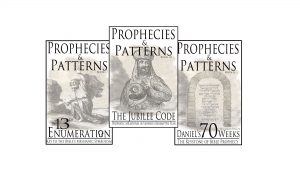 I need some help. For nearly two decades now I’ve been searching the works of some of the most respected Biblical scholars, looking for answers for what I’ve termed, the Artaxerxes Assumption. As I’ll explain in a moment, the Artaxerxes Assumption is a pivotal piece of Biblical history and to date I’ve only found a few scholars who have attempted to addressed the subject. I’ve come to realize, as much as I hate to admit it, that I can’t read every book or publication that might have been written on the subject so I’m asking for your help.
I need some help. For nearly two decades now I’ve been searching the works of some of the most respected Biblical scholars, looking for answers for what I’ve termed, the Artaxerxes Assumption. As I’ll explain in a moment, the Artaxerxes Assumption is a pivotal piece of Biblical history and to date I’ve only found a few scholars who have attempted to addressed the subject. I’ve come to realize, as much as I hate to admit it, that I can’t read every book or publication that might have been written on the subject so I’m asking for your help.
Here’s the offer. I’m offering $500 to the first person who can help me find one of today’s leading Biblical authors who has (at some point previous to 1/25/2018 ) addressed several pertinent subjects which have direct bearing on the Artaxerxes Assumption. For right now I want to focus on the list of authors provided at the end of this article. If this challenge is successful I may expand the search at a later date.
Note: If you are one of these authors in the list below, and have not addressed the challenges related to the Artaxerxes Assumption, but would like to have the opportunity to address the subject I’d be happy to post your thoughts on the subject at this blog and at my site www.danielsseventyweeks.com. (Please note your explanations will not qualify for the $500.)
If you are an author not listed in this article and would also like to have an opportunity to share your thoughts on the Artaxerxes Assumption I’d like to hear from you as well. (Please note your explanations will not qualify for the $500.) There are some additional terms and conditions, but I’ll explain them below.
The Keystone of Bible Prophecy
For a better understanding of the importance of the Artaxerxes Assumption, let me give you a brief overview of the subject. Most Christians have heard of the prophecy of 70 Weeks found in Daniel chapter 9. This prophecy is an amazingly specific prediction of when the Messiah will come. In fact, it is the only prophecy in the Bible which provides a specific chronologically verifiable starting point from which we can determine a date for the coming of the Messiah Yeshua (Jesus). No other prophecy in the Bible provides this information. To give you a sense of the importance of this prophecy, here are a couple of quotes from two highly knowledgeable and respected prophecy teachers:
“The interpretation of the revelation of Daniel concerning the seventy weeks (Daniel 9:24-27) constitutes one of the determining factors in the whole system of prophecy…. The interpretation of this passage inevitably colors all other prophetic views, and a proper understanding of it is the sine qua non of any student of prophecy.” – John F. Walvoord
“I am convinced that in the predictions of 70 weeks, we have the indispensable chronological key to all New Testament prophecy” – Alva J. McClain
Pretty powerful statements, don’t you think? Not only does this great prophecy tell us when the Messiah will come, but as these two scholars acknowledge, the 70 Weeks prophecy is in fact the basis upon which much of our eschatological (end times) understanding rests. In other words, our understanding of the 70 Weeks prophecy is largely responsible for how we see the 1st and 2nd coming of the Messiah. It influences how we see the end of this age, the great (7 year) tribulation, the rapture, the Anti-Christ, the Jewish people’s return to the Promise Land, and even the millennial reign of Christ.
So with this heavy theological weight resting on it, it is only reasonable to expect that the starting point of this prophecy would be established upon a rock solid incontrovertible foundation, so that the eschatological interpretations we build upon that footing can be confidently shared as proof of the exceptional nature of the Bible’s prophetic record.
The Artaxerxes Assumption
This is where the Artaxerxes Assumption enters the picture. Today, the vast majority of interpretations of the 70 Weeks prophecy rests on a well-meaning assumption about the chronology of Ezra, Nehemiah, and a Persian king named Artaxerxes Longimanus.
Surprisingly, this assumption about Artaxerxes Longimanus didn’t originate in our generation. In fact, this intriguing chronological conundrum originated nearly 2000 years earlier with the Messianic expectations of the Jewish people in the 1st century BC & AD. 300 years ago one of most renowned scientists of all time had this to say about the subject:
Those Jews who took Herod for the Messiah, and were thence called Herodians, seem to have grounded their opinion upon the seventy weeks of years, which they found between the Reign of Cyrus and that of Herod: but afterwards, in applying the Prophesy to Theudas, and Judas of Galilee, and at length to Barchochab, they seem to have shortened the Reign of the Kingdom of Persia.”
 Anyone care to guess who made the quote above? It may come as a surprise to some, but it was Sir Isaac Newton who wrote those words in his book Chronology of Ancient Kingdoms Amended. What’s fascinating about Newton’s discovery is that those early messianic expectations resulted in a series of assumptions which caused the Jewish people to eclipse over two centuries of Persian history.
Anyone care to guess who made the quote above? It may come as a surprise to some, but it was Sir Isaac Newton who wrote those words in his book Chronology of Ancient Kingdoms Amended. What’s fascinating about Newton’s discovery is that those early messianic expectations resulted in a series of assumptions which caused the Jewish people to eclipse over two centuries of Persian history.
Now two millennia later those assumptions are still influencing how we view the Bible and the chronology of the 2nd temple era. As Mark Twain is purported to have said,
“History doesn’t repeat itself but it does rhyme”.
To get to the real root of the problem, it is imperative to understand the prophecy within the context of the 2nd temple era. The starting point for the prophecy of Daniel 9 (which was the basis for each of the failed messianic claims noted by Newton) began with a “commandment to restore and to build Jerusalem”.
Know therefore and understand, that from the going forth of the commandment to restore and to build Jerusalem unto the Messiah the Prince shall be seven weeks,… (Daniel 9:25a)
As explained in my article A Divine “Command” to Return and Build Jerusalem and in my book Daniel’s 70 Weeks: The Keystone of Bible Prophecy there was only one “commandment to restore and to build Jerusalem” the Jewish people would have readily recognized. That command was the Divine command given by YHWH, proclaimed by Haggai and Zechariah and witnessed by Ezra 6:14.
Here is how the “Artaxerxes Assumption” enters the picture. The Divine command “to restore and to build Jerusalem” was given in the 2nd year of Darius who was also known historically as “Artaxerxes”. (Newton incorrectly attributed the commandment to Cyrus). When the Asmonaeans calculated the 70 weeks of Daniel from the 2nd year of Darius (Artaxerxes) it allowed them to claim that Judas Maccabaeus was the promised messiah. When Judas failed to usher in the Messianic kingdom, the prophecy was recycled for the next Jewish messianic figure.
Since the Divine command was given in the 2nd year of Darius also known as “Artaxerxes”, the next generation of Jewish messianic expectants just shifted the prophecy to the 2nd year of another Persian Artaxerxes so they could make their calculations work. With the end of the Bar Cochab rebellion in the first part of the 2nd century, the use of Daniel 9 to claim the start of the Messianic era had run its course, the Rabbinic calendar was reset, and 241 years of Persian history were erased from Jewish history. Along with that rewriting of 2nd temple history, the chronological context of the prophecy of Daniel 9 was left hopelessly muddled.
To this day, the Rabbinic calendar still reflects the chronological mistakes originating in the expectations of those early messianic believers. Unfortunately, the “Artaxerxes Assumption” of the 1st centuries BC/AD set in motion the chronological confusion which our generation has inherited. It seems many Christian chronologists today have borrowed some of the historical errors of the early messianic expectants, most being unaware of the Biblical facts and chronology that gave rise to those errors.
 This confusion was further compounded around the turn of the twentieth century, when a Scotland Yard investigator named Sir Robert Anderson wrote a wonderful book on the 70 Weeks prophecy of Daniel 9 entitled The Coming Prince. In his explanation of this great prophecy, Anderson revitalized the “Artaxerxes Assumption.” This time instead of erasing the Persian chronology like his Jewish predecessors, Anderson stretched the Biblical chronology of Ezra and Nehemiah by inserting a 58 year gap between Ezra 6 & 7. Like his 1st century predecessors, Anderson borrowed the title of Artaxerxes from Darius ‘the Great’ and applied it to the Persian king Longimanus. Today, Anderson’s chronology is the basis for most scholars’ writings on the subject of Daniel 9. Regrettably, his good intentions were a little short on reasonable chronological evidence from the Bible.
This confusion was further compounded around the turn of the twentieth century, when a Scotland Yard investigator named Sir Robert Anderson wrote a wonderful book on the 70 Weeks prophecy of Daniel 9 entitled The Coming Prince. In his explanation of this great prophecy, Anderson revitalized the “Artaxerxes Assumption.” This time instead of erasing the Persian chronology like his Jewish predecessors, Anderson stretched the Biblical chronology of Ezra and Nehemiah by inserting a 58 year gap between Ezra 6 & 7. Like his 1st century predecessors, Anderson borrowed the title of Artaxerxes from Darius ‘the Great’ and applied it to the Persian king Longimanus. Today, Anderson’s chronology is the basis for most scholars’ writings on the subject of Daniel 9. Regrettably, his good intentions were a little short on reasonable chronological evidence from the Bible.
First, Anderson ignored the contextual relevance of YHWH’s command “to restore and to build Jerusalem.” Unlike his 1st century Jewish messianic predecessors, Anderson saw no reason to begin the prophecy with the words of YHWH the living God of the Bible. Next, Anderson assumed the “Artaxerxes” of Nehemiah and Ezra was Artaxerxes Longimanus because that was the only way he could show that the prophecy of 70 Weeks was fulfilled in Yeshua (Jesus). Unfortunately, Anderson did not base this assumption upon any real Biblical evidence that he was willing to share, but instead upon a single well-meaning but unsubstantiated statement of the Christian historian Rawlinson, found in Rawlinson’s translation of Herodotus, vol. 4, p.217 . This quote as taken from Anderson’s The Coming Prince is as follows:
Artaxerxes I. reigned forty years, from 465 to 425. He is mentioned by Herodotus once (6. 98), by Thucydides frequently. Both writers were his contemporaries. There is every reason to believe that he was the king who sent Ezra and Nehemiah to Jerusalem, and sanctioned the restoration of the fortifications.” – RAWLINSON, Herodotus, vol. 4., p. 217.
“Every reason to believe” even coming from a Biblical historian of Rawlinson’s stature does not exactly constitute proof that Artaxerxes “was the king who sent Ezra and Nehemiah to Jerusalem.” But that statement is the sum of Anderson’s arguments for his Artaxerxes Assumption.
Anderson, by all accounts, was an exceptional Biblical scholar. To be fair to Anderson, his assumption was understandable, considering Ussher, Newton, Rawlinson, and Josephus were of the same general opinion concerning “Artaxerxes” and his contemporaneous relationship to Ezra and Nehemiah.
I mean, what kind of person argues with the opinion of some of the greatest Biblical chronologists of all time? Okay, I must admit this homeschooled high school educated plumber is raising his hand timidly from the back of the room. But with all due respect to these great men, it seemed to have been a case of each thinking the other had done his homework.
In the case of Daniel 9 and the Artaxerxes Assumption, it seems their messianic zeal, like their 1st century Jewish counterparts, have caused them to make an assumption which so far seems to be unsupported by a reasonable rendering of the Bible’s chronology. I appreciate the fact that so many well respected and incredibly intelligent scholars believed Ezra and Nehemiah were contemporaries of Artaxerxes Longimanus and I understand the convenience of this assumption, but is that sufficient proof upon which to establish the most important prophecy in the Scripture? Where is the reasonable Biblical evidence for such a pivotal determination?
Since I learned of Newton’s discovery and its associated Artaxerxes Assumption, I’ve been trying to understand how other authors and scholars who have studied the subject of Daniel 9 have reconciled the Bibles 2nd temple era chronology with an interpretation of Daniel 9 which sees Ezra and Nehemiah as contemporaries of the Persian king Artaxerxes Longimanus. What Biblical evidence is there for this association? How did they reconcile the chronological statement of the Bible and secular history which seem to refute this assumption?
Your Help is Needed
So this is why I need your help. As I said before I can’t read every article or book ever written on the prophecy of Daniel 9, nor can I email, tweet, or facebook every author who has written on the subject asking if they would be willing to share with me the Biblical evidence they used to solve their Artaxerxes Assumption.
So I’m hoping with your help we might be able find out how these authors solved the Artaxerxes Assumption in their own explorations of the subject.
Here is what I’m looking for in order for you to win this challenge. In any of the currently existing written works of the authors listed in the table below I am looking for examples where they have explained (Scripturally) the chronological challenges posed by the following six Biblical subjects related to the Artaxerxes Assumption:
Biblical Challenges to the Artaxerxes Assumption
- The statement of Ezra 6:13-15 and the identity of “Artaxerxes”
- The identities of the “Artaxerxes” of Ezra 4:7, 8:1; Nehemiah 2:1
- The age of Ezra whose father died in the 19th year of Nebuchadnezzar
- The age of the priests and Levites of Nehemiah 10 & 12
- Nehemiah 12:26 & the age of the 2nd temple porters of Neh. 11:19 & 12:25-27
- The chronological flow of Ezra 6 & 7
In order to collect the $500 you must be the 1st person to post in the comments section of this blog post, excerpts from the currently existing works (as of 1/25/2018) of any one of the authors listed in the table below which clearly explain how they reconciled the above six Biblical challenges to the Artaxerxes Assumption. In order for your entry to be considered valid the excerpted explanations you present from one of these authors must adhere to the following guidelines:
- The quotes provided must adhere to fair use guidelines and must be referenced.
- The author’s interpretation quoted must adhere to the Golden Rule of Bible interpretation as described by Dr. David L. Cooper:
“When the plain sense of Scripture makes common sense, seek no other sense; therefore, take every word at its primary, ordinary, usual, literal meaning unless the facts of the immediate context, studied in the light of related passages and axiomatic and fundamental truths, indicate clearly otherwise.” – Dr. David L. Cooper
- The author’s answers cannot contradict another passage of Scripture.
- The author’s explanation must adhere to the Exponential Decay Curve as explained by Ed Hindson and Thomas Ice in their book, Charting the Bible Chronologically – unless a reasonable argument, with supporting Biblical evidence and examples, can be made as to why an exception to this rule is justified in the case of any 2nd temple era individuals or groups.
- Any quoted explanation which uses as its basis an explanation which questions the integrity of the original Biblical texts will also be disqualified. (This does not include reasonable questions regarding differing interpretations of the text.)
 Additional Prizes:
Additional Prizes:
In addition to the $500 reward I’m also offering a free printed copy of one of my Prophecies & Patterns series books (your choice) to the first 25 readers of this blog who can find an author listed in the table below who has answered any two of the six Biblical challenges related to the Artaxerxes Assumption. (You must post their explanations in the comment section of this blog post.) I’ll send the printed book anywhere in the world the US postal service delivers. Same terms, conditions, and guidelines apply to these answers as are required for the $500.00 prize.
Stewardship as the Time Draws Near
In closing, I wish to stress that for those of us who are earnestly looking for the return of Yeshua, an accurate understanding of the prophecy of 70 Weeks is of paramount importance. As faithful stewards of Yahweh’s prophetic words, it is imperative that as this age draws to a close our prophetic worldview be based upon real Biblical evidence that does not call into question the credibility of the Biblical record.
My hope is that this challenge, will ultimately result in all of us holding each other to a higher standard of prophetic interpretation. No prophecy in the Bible is of any private interpretation and must find its foundation in the inspired words of the sixty six books we call the Bible. I’m asking for your help to ensure that the 70 Weeks, the Bible premier prophecy, is established upon such a secure foundation.
I hope you’ll join me in this worthy endeavor.
Maranatha!
Further Terms and Conditions:
This challenge is void where prohibited. You must be 18 years or older to participate. The $500 dollars reward will be sent as a check anywhere in the 50 US states or its territories. If you live outside the United States and would like to participate I will award the money in your name to a Biblically based charity of your choice (I reserve the right to exclude any charity that I do not approve of).
Authors Who Wish to Respond
If you are an author who has written about the prophecy of 70 Weeks (listed in this article or not) and would like the opportunity to share your perspective on the six points related to the Artaxerxes Assumption, I’d love to hear from you. All I ask is you abide by the five guidelines above, you answer the six points, and you keep your explanations on topic, respectful, and as brief as possible. I also ask that you use your real name. If your explanation abides by all the terms outlined in this article I will provide you a dedicated blog page in your name where you can share your perspective.
Any explanations or comments that do not adhere to the above guidelines or that are in any way derogatory towards an individual or group will be rejected without explanation. Authors can email their explanation of the following six point of the Artaxerxes Assumption to me at williamstruse@danielsseventyweeks.com
I look forward to hearing from you and seeing the subject through your eyes.
Reminder:
To have your explanation published on this site please explain the following six points as they relate to the Artaxerxes Assumption, using the guidelines outlined above:
Biblical Challenges to the Artaxerxes Assumption
- The statement of Ezra 6:13-15 and the identity of “Artaxerxes”
- The identities of the “Artaxerxes” of Ezra 4:7, 8:1; Nehemiah 2:1
- The age of Ezra whose father died in the 19th year of Nebuchadnezzar
- The age of the priests and Levites of Nehemiah 10 & 12
- Nehemiah 12:26 & the age of the 2nd temple porters of Neh. 11:19 & 12:25-27
- The chronological flow of Ezra 6 & 7
Further Research on the Artaxerxes Assumption:
For those looking for more information on the Artaxerxes Assumption you can download my book Daniel’s 70 Weeks: The Keystone of Bible prophecy for free by clicking on the following link: Book Download. You’ll also find several articles I’ve written about the subject in menu listed on the right side of this page.
For a different point of view on the subject I would also recommend Dr. Floyd Nolan Jones’s book The Chronology of the Old Testament. Dr. Jones is one of the few Biblical scholars I’ve had the privilege of corresponding with who has tried to solve the Artaxerxes Assumption. Though I do not agree with his ultimate conclusions, he at least acknowledges the importance of the subject to Biblical history and Bible prophecy.
For another perspective, David Austin at Creation.com has written an excellent article on the subject. Although I do not agree with his conclusions regarding Daniel 9 and a shorten Persian chronology, his article Darius is Artaxerxes provides a lot of good information on the subject.
List of authors who may have written about the Artaxerxes Assumption:
| · Alan Kurschner | · Joel Rosenberg |
| · Andrew B. Ray | · John Hagee |
| · Andy Woods | · John MacArthur |
| · Arnold Fruchtenbaum | · John Walvoord |
| · Barry Horner | · Jonathan Bernis |
| · Bill Cloud | · Jonathan Cahn |
| · Bill Koenig | · Joseph Farah |
| · Bill Salus | · Josh McDowell |
| · Billy Crone | · Ken Johnson |
| · Billy Hallowell | · Larry Spargimino |
| · Bob Theil | · Mark Biltz |
| · Brian Godawa | · Mark Hitchcock |
| · Britt Gillette | · Mark Toben |
| · Bryant Wright | · Matthew Hagee |
| · Carl Gallups | · Michael Heiser |
| · Charles Dyer | · Michael Brown |
| · Chuck Missler | · Michael Rydelnik |
| · Dave Williams | · Michael Vlach |
| · David James | · Michael Youssef |
| · David Jeremiah | · Mitch Glaser |
| · David Limbaugh | · Nathan Jones |
| · David Reagan | · Paul McGuire |
| · Derrick Gilbert | · Perry Stone |
| · Don Perkins | · Rabbi K.A. Schneider |
| · Douglas Hamp | · Randall Price |
| · Douglas Stauffer | · Ray Bentley |
| · Douglas Woodward | · Robert Jeffress |
| · Ed Hindson | · Rodrigo Silva |
| · Frank Turek | · Ron Cantor |
| · Gary Stearman | · Ron Rhodes |
| · Greg Laurie | · Russell Stendal |
| · Hank Hanegraaff | · Ryan Speakman |
| · Jack Kelley | · Samuel Whitefield |
| · Jake McCandless | · Sid Roth |
| · James Prasch | · Stan Guthrie |
| · James White | · Terry James |
| · Jan Markell | · Thomas Horn |
| · JD Hall | · Thomas Ice |
| · Jeff Kinley | · Tim LaHaye |
| · Jim Fletcher | · Troy Anderson |
| · Joel Richardson | · Walid Shoebat |
